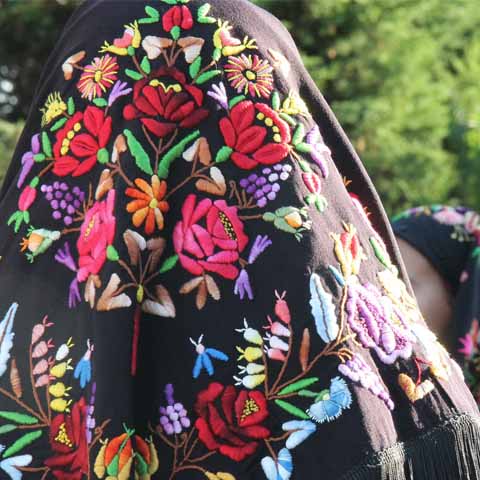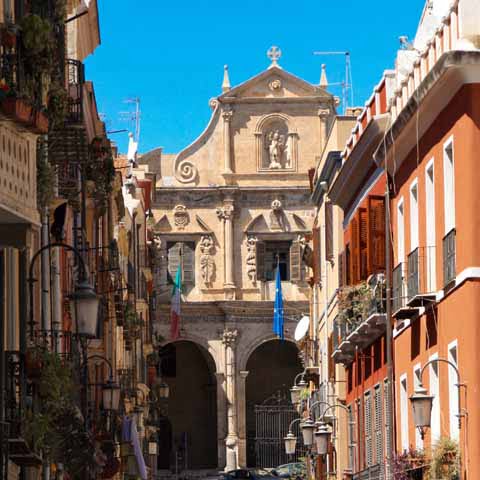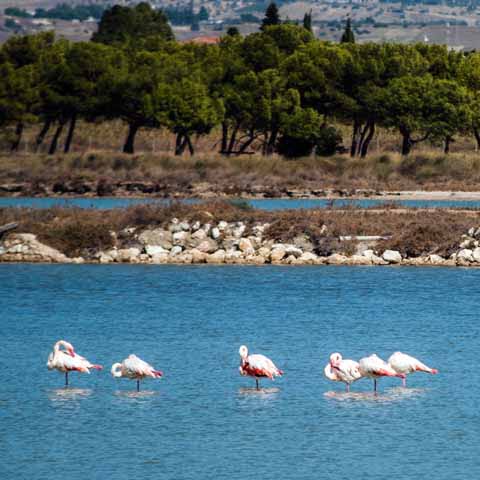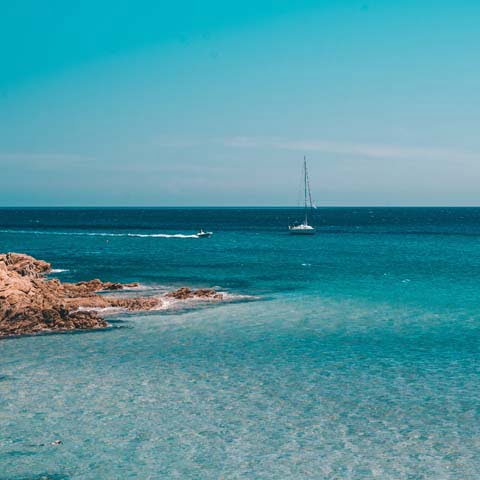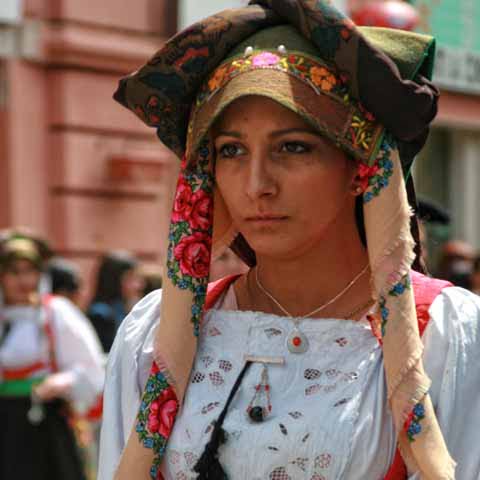Just west of mainland Italy is the Italian island of Sardinia, of which the city of Cagliari is the capital. This picturesque city is full of ancient history that traces all the way back to the Neolithic period and still has visible remnants of the medieval period in the Castello district. Whether you choose to check out the architecture of the Castello district and local churches, the many libraries, the Teatro Lirico opera house, or just wander the city in amazement, Cagliari is full of rich tradition and culture that will captivate your senses and capture your heart.
ARCHITECTURE IN CAGLIARI
The Basilica of San Saturnino, which features Byzantine and Romanesque elements, is thought to be one of the oldest churches in Cagliari and is estimated to be from the fifth century. It is dedicated to the patron saint of the city, Saturnino, who legend says was decapitated for refusing to reject his Christian faith. Some parts of the original basilica remain despite renovations over the years. Today the structure is fairly simple and understated in its outward appearance but is still visited often for its historical significance.
The medieval town of Castello is considered to be part of the upper city as it sits atop a hill and overlooks the stunning waters of the gulf. Much of the city walls are still here along with two highly visited fourteenth century towers, Torre di San Pancrazio and Torre dell’Elefante. Both towers are made from the area’s locally mined white limestone and share a gate, which is the main entrance to Castello. Each tower has a defining feature. Torre di San Pancrazio is known for its up to ten feet thick protective walls, and Torre dell’Elefante is best known for the elephant statue for which it is aptly named.
The Cathedral of Cagliari is one of the most prominent churches of Castello. Originally constructed in the Pisan-Romanesque style, it is thought to have been built in the thirteenth century and has received renovations over the years. At close to one hundred feet tall the church is made of the area’s trademark white limestone and features a bell tower and wide stairway leading up to the main entryway. The many arches featured on its façade are a defining trait of this structure.
Along with the cathedral, the Basilica of Our Lady of Bonaria is perhaps the other most well-known church in Cagliari. The church, which features Gothic elements, is thought to have origins in the fourteenth century and features The Shrine of Our Lady of Bonaria, sometimes called Our Lady of Fair Winds, which is dedicated to the Blessed Virgin Mary. The basilica has an interesting folklore legend behind it that says a ship caught in a vicious storm was forced to throw some of its cargo overboard, but when a particularly large crate hit the water the storm is said to have ceased immediately. The ship abandoned the crate which then washed upon the shore in Cagliari. The townspeople were unable to open the crate and called for the local friars who were able to open it with ease. Inside the crate was a statue of the Blessed Virgin Mary and Child. It is said that is the same statue that resides in the basilica today. The basilica has received visits from important figures such as Pope Benedict XVI and Pope Francis during the beginning of the twenty-first century.
Across from the church is the Monumental Cemetery of Bonaria. The site of the cemetery was at one time used as a necropolis by the Ancient Romans and as a burial place by the early Christians. The architectural designs of the cemetery are reminiscent of an outdoor art gallery featuring sculptures by local artists as well as artists from other parts of Sardinia and the country. Architectural and artistic styles that can be observed here include Neoclassicism, Realism, and Liberty (Art Nouveau).
The Capo Sant’Elia Lighthouse is among the most historic lighthouses on the island. Dating back to the nineteenth century, the lighthouse can be found in the San Bartolomeo District and its architecture consists of a tower decorated with wide black and white stripes.
As for ancient architecture, Capri is home to a Roman Amphitheater, which can be found in a valley of the Buon Cammino Hill. The amphitheater, which dates back to the first century BC, could host an average of 10,000 people during gladiator fights during its peak.
Also from the Roman period is Tigellio’s Villa. The villa is an excellent example of Roman aristocratic living during the first century BC and consists of three domus as well as a spa building with a perforated brick floor. Today, the villa complex is a highly regarded archeological site.
ART IN CAGLAIRI
Artwork can be seen throughout the city in some of the basilicas and galleries, including Galleria Crobu, Galleria Comunale d’Arte, and more. Both art galleries focus on local Sardinian art, with the Galleria Comunale d’Arte featuring twentieth century and contemporary works by local artists, and the Galleria Crobu hosting exhibits of ancient and contemporary local art, with a special emphasis on twentieth century Sardinian artists.
Beautiful works of art by local artisans are on display at the Collezione Sarda Luigi Piloni. Located in the main University of Cagliari building in Castello, the museum showcases a wide variety of objects including paintings, maps, historic costumes, prints, jewelry, and other artisanal works.
Also in Castello, art lovers can visit the Pinacoteca Nazionale. This ample art gallery features paintings by Sardinian artists from the sixteenth century to the twentieth century, as well as works by artists from Genoa, Naples, Rome, and Catalonia. Represented artists include Juan Matès, Pietro Cavaro, and Antioco Mainas.
A more unconventional art the city of Cagliari is known for has roots in the Centro Internazionale del Fumetto or the International Comic Strip Center. This school which encourages and engages those who excel at creating comic books has been a part of the city for years. The founders of the center are credited with creating famed Italian comic book characters Legs Weaver and Nathan Never.
The sculptures of Costantino Nivola, a native Sardinian artist, reflect the long history of Cagliari and the rest of the island of Sardinia. Nivola’s works are on display throughout Italy and other parts of the world, including in the United States. In Cagliari, Nivola’s sculptures can be admired in the regional government building.
LITERATURE
Although the literary culture in Cagliari is rich, perhaps one of the best-known works about the city is Sea and Sardinia. The poem was originally written by D. H. Lawrence after his trip to the city in the early twentieth century. For Lawrence, one of the particularly unique aspects of the city was the way the sunlight hit the limestone buildings, giving them an unusual white-washed effect that reminded him of Jerusalem.
Cagliari is a city of literary tradition. A number of libraries can be found throughout the city, and in many of them you may find the works of authors who were born in or wrote fondly of the city.
The first known Sardinian literary author is considered to be Bishop Lucifer of Cagliari who primarily wrote religious and political pamphlets in the fourth century. Also from that time period was author Claudius Claudianus, sometimes referred to simply as Claudian, who was a roman poet that wrote mythology and about Cagliari.
Later writers of the beauty of Cagliari included sixteenth century poet Roderigo Hunno Baeza, seventeenth century Juan Francisco Carmona who wrote a Spanish hymn to the city, and seventeenth century writer Jacinto Arnal De Bolea who wrote a Spanish novel called El Forastero which was set in Cagliari.
MUSIC
Opera has long been a true musical love of Cagliari, and the main opera house of Teatro Lirico and the presence of the International Music Academy well represent that sentiment.
Teatro Lirico was built after other prominent Cagliari theaters were destroyed by World War II or fires. The theater opened in the last decade of the twentieth century and now features more than a thousand seats as well as a bar, restaurant, and a shop for patrons.
The International Music Academy was established in the early twenty-first century and is a creative way to keep the music alive in Cagliari. This international school educates young and talented musicians from all over the world.
Italian opera singer Giovanni Matteo Mario, sometimes simply referred to as Mario, was a nineteenth century tenor. He was born into an aristocratic family in Cagliari and did not begin pursuing a singing career in earnest until he was exiled to Paris. Mario performed at many theaters across Italy and became world renowned for his exceptional gift of singing tenor.
Bernadette Manca di Nissa was also born in Cagliari. This twentieth century opera singer has sung opera across Italy and the globe. She has now retired from the opera stage and focuses on teaching singing at Conservatorio di Cagliari.
Twenty-first century Italian singer Marco Carta is perhaps one of the more modern-day musical success stories. He began his singing career on an Italian talent show and after winning began his career in earnest. Carta has sold over two hundred thousand pop albums to date.
CINEMA
Cagliari is known for annual film festivals that celebrate well-known and less-known pictures of the cinematic industry. The goal is to promote development of the Italian film culture in Cagliari and Sardinia. These events generally celebrate short films, documentaries, and others in an effort to raise awareness of different film genres.
With its stunning natural beauty, the island of Sardinia has been a preferred backdrop for quite a few Italian films. As the Cagliari tourism industry grows and the effects of annual international film multiply, it is likely only a matter of time before the cinematic industry increasingly looks to the gorgeous seaside city of Cagliari as a setting for future films.
Movies that have been filmed or set in Cagliari over the years include: La calda vita (1963), Boom! (1968), Un poliziotto sull’isola (1993), Il figlio di Bakunin (1997), Finalmente la felicità (2011), Bellas mariposas (2012), Dimmi che destino avrò (2012), Quo Vado? (2016), and Domino (2019).
SCIENCE
Cagliari is home to the Museo delle Cere Anatomiche, which displays an impressive collection of wax anatomical models. Together with the Museo della Specola in Florence, it is considered to be the most important museum of its kind in Italy. The realistic models have contributed to advances in modern medicine and today allow visitors to explore the link between Cagliari and medical history.
In addition to serving as Sardinia’s capital, Cagliari is considered to be the main cultural hub of the scenic island. Sardinia’s vast history can be explored in Cagliari’s museums and archeological sites, while the monuments and local art found here attest to the unique culture that can only be found in Sardinia.
Don't just see Italy, live it.
Your dream trip to Italy has never been closer
No more endlessly scrolling travel sites. Our travel experts will craft the perfect, one-of-a-kind trip just for you.

300+
DESTINATIONS
We offer more Italian destinations than any travel site. Do and see more with Trips 2 Italy.
1 (of a kind)
ITINERARIES
Because your dream trip to Italy should be designed for you, not for the masses.
100%
PEACE OF MIND
From flights and accommodations, to food and activities - we take care of every detail.
